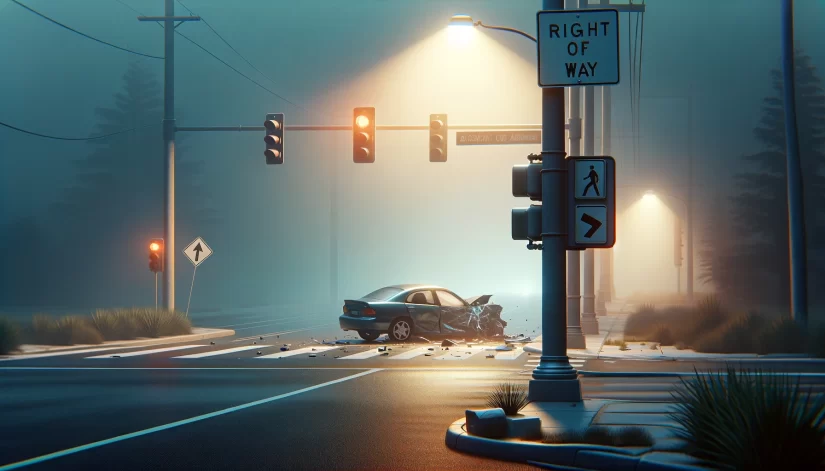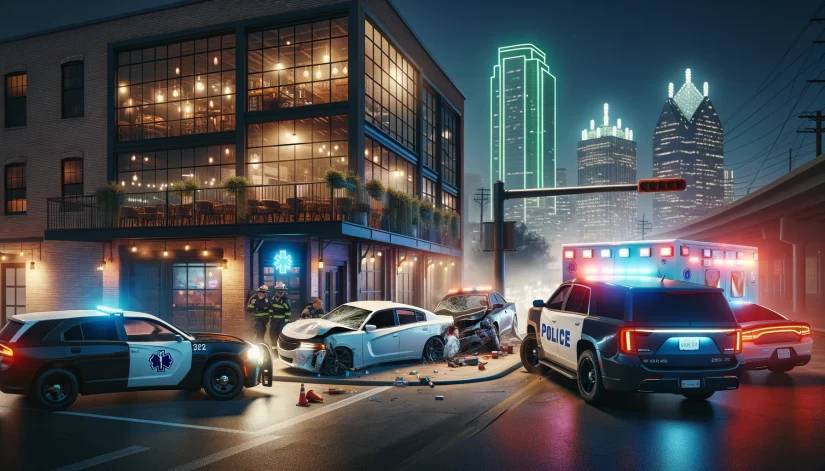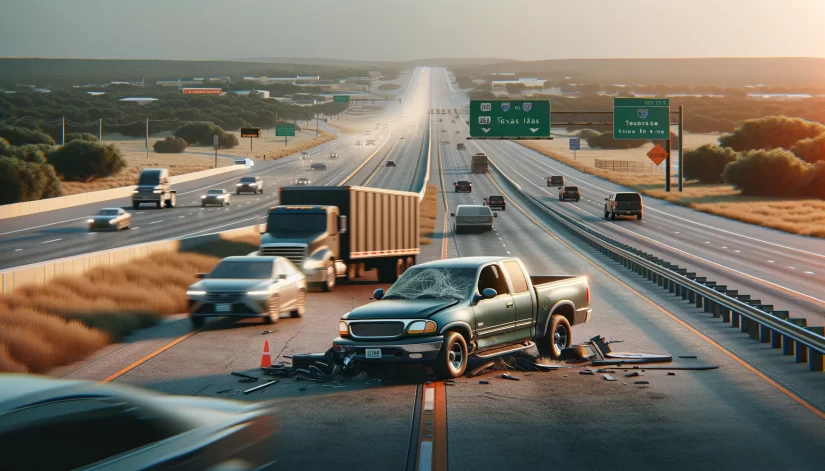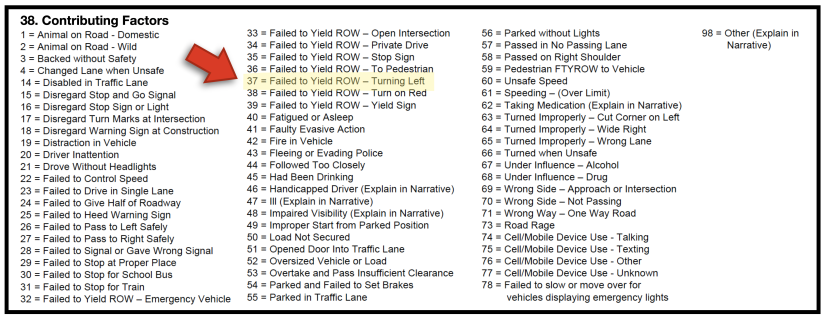7 Leading Causes of Fatal Car Accidents in Texas (2023)
January 9, 2024

In 2023, Texas saw many car crashes. A total of 550,873, to be exact. Sadly, 3,727 of these were deadly.
- Total Crashes: 550,873
- Fatal Accidents: 3,727
- Lives Lost: 4,124
This article looks at the main causes of these fatal crashes. This article is based on data in TXDOT’s CRIS system.
Here’s an overview:
- Key Takeaways
- 1. Loss of Vehicle Control: 1,395 Fatalities
- 2. Failure to Yield Right of Way: 845 Fatalities
- 3. Impaired Driving: 332 Fatalities
- 4. Reckless and Aggressive Driving: 139 Fatalities
- 5. Distracted Driving: 131 Fatalities
- 6. Prohibited Road Use: 67 Fatalities
- 7. Impaired Visibility: 31 Fatalities
- Miscellaneous Causes
- Understanding and Preventing Fatal Car Accidents
- How a Personal Injury Lawyer Can Help in the Wake of a Fatal Car Accident
- Methodology: Understanding Texas Crash Report Codes
Key Takeaways
- Loss of Vehicle Control as Major Cause: The primary reason for fatal car accidents in Texas in 2023, resulting in 1,395 deaths, emphasizes the need for improved driver training and awareness.
- Failure to Yield Resulting in Fatalities: Contributing to 845 deaths, this highlights the importance of following traffic signs and signals.
- Reckless Driving a Notable Fatal Factor: Aggressive driving behaviors, including evading police and road rage, led to 139 fatalities, pointing to a serious issue on Texas roads.
- Underreporting of Cell Phone-Related Accidents: Few fatal accidents were officially attributed to cell phone use, suggesting potential underreporting.
- Varied Causes in ‘Other’ Fatal Accident Category: Accounting for 356 deaths, this category shows the diverse and unpredictable nature of fatal road accidents.
- Fatal Accidents Caused by Impaired Visibility: Directly linked to 31 fatalities, poor visibility conditions underscore the need for clear vision while driving.
- Data Gaps in Fatal Car Accident Reporting: The 2023 Texas road safety report reveals interesting discrepancies, especially in reporting cell phone-related fatalities, offering key insights into accident data analysis challenges.
1. Loss of Vehicle Control: 1,395 Fatalities

Loss of vehicle control significantly contributed to fatal car accidents in Texas in 2023. This category, accounting for 1,395 fatal car accidents, encompasses a range of driving behaviors that lead to drivers not maintaining control of their vehicles.
Here we detail each specific behavior and its associated risks:
Failure to Drive in Single Lane: 538 Fatalities

Drivers veer out of their lane, often due to distraction or poor steering control.
This behavior can lead to head-on collisions or side-swipes with other vehicles, dramatically increasing the risk of fatal accidents.
Failure to Control Speed: 376 Fatalities
- Involves driving at a speed that is inappropriate for the conditions or beyond the driver’s ability to safely control the vehicle.
- Speeding reduces reaction time and increases the severity of crashes, making fatal outcomes more likely.
Driving at an Unsafe Speed: 337 Fatalities
- Driving faster than is safe for current road, weather, or traffic conditions.
- Such speeding can lead to losing control, especially in adverse conditions like rain or heavy traffic, raising the risk of fatal accidents.
Driving Over the Speed Limit: 144 Fatalities
- Exceeding the posted speed limits, often significantly.
- Excessive speed makes it harder to respond to road hazards and increases the impact force in accidents, leading to more severe injuries or fatalities.
2. Failure to Yield Right of Way: 845 Fatalities

Failure to yield right of way was another major cause of fatal car accidents in Texas in 2023. This category includes incidents where drivers did not give way when required, leading to 845 fatal car accidents.
Below, I explain each behavior under this category and its associated risk.
Pedestrian Failure to Yield Right of Way to Vehicle: 498 Fatalities
- Occurs when pedestrians do not yield the right of way to vehicles, often resulting in fatal collisions.
- Such pedestrian errors can lead to severe accidents, with a high risk of fatality due to the vulnerability of pedestrians.
Failure to Yield Right of Way at Stop Sign: 145 Fatalities
- Occurs when a driver does not stop or yield at a stop sign.
- Ignoring stop signs can lead to dangerous intersection collisions, often resulting in severe or fatal injuries.
Failure to Yield Right of Way When Turning Left: 122 Fatalities
- Involves drivers not yielding while making left turns, usually in front of oncoming traffic.
- This mistake can cause head-on or side-impact crashes, significantly increasing the risk of fatalities.
Failure to Yield Right of Way on Private Drive: 39 Fatalities
- Involves drivers not yielding when entering or exiting private drives, including parking lots and residential driveways.
- This can cause collisions with oncoming traffic or pedestrians, leading to serious injuries or fatalities.
Failed to Yield Right of Way at Yield Sign: 24 Fatalities
- Drivers do not properly yield at yield signs, often merging or crossing unsafely.
- Failing to yield can lead to crashes, especially at high speeds, increasing the likelihood of fatal outcomes.
Vehicle Failure to Yield Right of Way to Pedestrian: 17 Fatalities
- Happens when drivers fail to give right of way to pedestrians, often at crosswalks.
- Such failures can lead to pedestrian accidents, which are more likely to be fatal due to the vulnerability of pedestrians.
3. Impaired Driving: 332 Fatalities

Impaired driving was a critical factor in car accident fatalities in Texas in 2023. This category includes driving under the influence of alcohol, drugs, or other impairments, leading to 332 fatal road accidents.
Here, we discuss each type of impairment and its associated risks.
Driving Under the Influence of Alcohol: 234 Fatalities
- Driving after consuming alcohol impairs judgment and reaction times.
- Alcohol-related impairment significantly increases the risk of causing severe and often fatal accidents due to reduced control and decision-making ability.
Driving Under the Influence of a Drug: 39 Fatalities
- Involves operating a vehicle while under the influence of drugs, which can be legal or illegal.
- Drug impairment, like alcohol, affects a driver’s ability to react and make safe decisions, leading to a higher likelihood of fatal crashes.
Had Been Drinking: 33 Fatalities

- Refers to drivers who had consumed alcohol, even if not legally impaired.
- Any level of alcohol consumption can affect driving ability, increasing the risk of fatal accidents due to slower reactions and impaired judgment.
Driving While Ill: 25 Fatalities
- Driving while seriously ill, which can affect concentration and physical control.
- Illness can lead to decreased alertness and control, making accidents more likely to be severe or fatal.
Driving Impaired by Medication: 1 Fatality
- Operating a vehicle while on medication that could impair driving ability.
- Certain medications can impair cognitive and motor functions, increasing the risk of a fatal accident due to decreased driving capabilities.
4. Reckless and Aggressive Driving: 139 Fatalities

In 2023, reckless and aggressive driving emerged as a significant cause of road fatalities in Texas. This category encompasses behaviors like evading police and exhibiting road rage, leading to 139 fatal accidents.
Here are the specific driving behaviors within this category that caused these tragic outcomes:
Faulty Evasive Action: 84 Fatalities
- Drivers making sudden, incorrect maneuvers to avoid a collision or hazard.
- These hasty and improper decisions often lead to losing vehicle control, causing fatal accidents.
Fleeing or Evading Police: 50 Fatalities
- Involves drivers attempting to escape police at high speeds.
- Such actions often lead to high-speed collisions with a high fatality risk.
Road Rage: 3 Fatalities
- Aggressive driving due to anger or frustration.
- Can escalate to dangerous actions on the road, resulting in fatal outcomes.
Failure to Slow or Move Over for Emergency Vehicle: 2 Fatalities
- Not slowing down or moving over for emergency vehicles.
- This negligence can lead to high-impact collisions, often with fatal consequences.
5. Distracted Driving: 131 Fatalities

In 2023, inattention and distraction were key factors in fatal road accidents in Texas. This category, responsible for 131 fatalities, includes behaviors such as driver inattention and using mobile devices while driving.
Below, we detail the specific actions within this category and their fatal consequences.
Driver Inattention: 113 Fatalities
- Occurs when drivers are not fully focused on the road, often due to multitasking.
- Lack of attention can lead to missed warnings or delayed reactions, increasing the likelihood of fatal accidents.
Distraction in Vehicle: 16 Fatalities
- Involves being distracted by something inside the vehicle, like passengers or objects.
- Internal distractions can divert a driver’s focus, leading to dangerous and potentially fatal collisions.
Talking on Mobile Device: 1 Fatality
- Using a cell phone for talking while driving.
- This splits the driver’s attention and can cause critical delays in response time, leading to fatal accidents.
Texting While Driving: 1 Fatality
- Texting while driving takes eyes off the road and hands off the wheel.
- This behavior is particularly dangerous as it significantly impairs the driver’s ability to react to road conditions and hazards.
Possible Reasons for Low Reported Cell Phone Usage in Fatal Accidents
Despite widespread awareness of the dangers of cell phone use while driving, the 2023 data from Texas shows surprisingly few fatal accidents officially attributed to this cause. There are several possible explanations for this discrepancy in the crash reports:
1. Underreporting Due to Lack of Evidence
It can be challenging for officers to conclusively determine cell phone use as a contributing factor unless there is clear evidence, such as eyewitness accounts or phone records.
Drivers involved in accidents might not admit to using their phones, and physical evidence can be hard to obtain, leading to underreporting.
2. Attribution to Other Causes
In many cases, the effects of cell phone use, such as inattention or delayed reaction, might be recorded under broader categories like ‘Driver Inattention’ or ‘Distraction in Vehicle.’
This could lead to a lower official count for accidents caused specifically by cell phone use.
3. Changing Patterns of Mobile Device Usage
There’s a possibility that drivers are increasingly using hands-free devices or voice commands, which might not be as easily identifiable as direct causes in accidents compared to handheld phone use.
However, even hands-free usage can be a distraction, potentially contributing to accidents in less obvious ways.
How a Texas Car Accident Lawyer Can Assist in Proving Cell Phone Distraction
In cases where cell phone distraction is suspected as a cause of a car accident, a Texas car accident lawyer can play a crucial role in uncovering evidence that may not have been available to the investigating officers.
Here’s how they can help:
| Service Provided by Car Accident Lawyer | Description |
| STEP 1: File a Lawsuit to Investigate the Wreck | A lawyer can file a lawsuit for the injured party or the family of a deceased victim to initiate the discovery process. |
| STEP 2: Subpoena Cell Phone Records | Lawyers can issue subpoenas to obtain cell phone records from the suspected distracted driver in car accident cases. |
| STEP 3: Hire Experts | Forensic experts, often working with lawyers, analyze evidence like cell phone records to establish a timeline leading up to the accident. |
6. Prohibited Road Use: 67 Fatalities

In 2023, accidents due to driving in prohibited areas led to many fatal accidents in Texas. This category, resulting in 67 deaths, includes behaviors such as passing in no-passing zones and stopping in traffic lanes.
This section details the actions within this category that led to these fatalities.
Passing in No Passing Lane: 36 Fatalities
- Involves overtaking other vehicles in areas where passing is not allowed, leading to fatal accidents.
- This reckless behavior often results in head-on collisions or side-swipes, with a high fatality rate.
Parked in Traffic Lane: 19 Fatalities
- Refers to vehicles stopping or parking in active traffic lanes, causing fatal accidents.
- These situations create unexpected obstacles for other drivers, often leading to high-impact and fatal crashes.
Failure to Stop for Train: 8 Fatalities
- Drivers failing to stop at railroad crossings, leading to collisions with trains, often result in fatalities.
- Collisions with trains are usually catastrophic, with a high likelihood of fatalities due to the train’s size and speed.
Driving on Improved Shoulder Lane: 4 Fatalities
- Involves driving on road shoulders, not meant for regular traffic, leading to deadly accidents.
- Using the shoulder unsafely can lead to fatal collisions with stationary vehicles or roadside hazards.
7. Impaired Visibility: 31 Fatalities

In Texas during 2023, impaired visibility was a notable factor in fatal road accidents. This category, which includes incidents where visibility issues played a major role, led to 31 fatalities.
Below, we examine the specific behaviors within this category that resulted in these fatalities.
Impaired Visibility: 23 Fatalities
- Refers to situations where the driver’s view is obstructed or visibility is otherwise impaired.
- Obstructions could be due to factors like heavy rain, fog, or objects blocking the windshield, leading to dangerous driving conditions and increased chances of fatal accidents.
Driving Without Headlights: 8 Fatalities
- Involves driving without headlights in low visibility conditions like night or fog.
- Lack of headlights significantly reduces a driver’s ability to see and be seen, increasing the risk of fatal collisions.
Tips for Safe Driving in Impaired Visibility Conditions
Driving in conditions where visibility is compromised can be challenging and dangerous. Here are some practical tips for navigating various impaired visibility situations safely:
Driving at Night or in Fog
- Use Appropriate Lighting: Always use headlights at night or in fog. Consider using fog lights if available.
- Reduce Speed: Lower your speed to allow more time to react to unseen hazards.
Driving in Heavy Rain or Snow
- Use Windshield Wipers and Defrosters: Ensure your wipers are in good condition and use defrosters to keep the windshield clear.
- Maintain a Safe Distance: Increase your following distance from other vehicles to account for longer stopping distances.
Sun Glare
- Use Sun Visors and Sunglasses: Utilize sun visors in your car and wear polarized sunglasses to reduce glare.
- Be Aware of Temporary Blindness: Be extra cautious, as bright sunlight can momentarily impair your vision.
Dirty or Obstructed Windshield
- Keep Windshield Clean: Regularly clean both the inside and outside of your windshield.
- Remove Obstructions: Ensure that nothing on your dashboard is blocking your view.
Miscellaneous Causes
In 2023, a range of miscellaneous and other factors were reported as contributing to fatal car accidents in Texas. This category, labeled as ‘Other’ in the data, accounted for 356 fatalities.
These factors often encompass less common but equally dangerous behaviors or conditions that led to fatal outcomes. This category includes a variety of less typical causes not covered under standard classifications.
Examples may include:
- mechanical failures,
- medical emergencies while driving, or
- unexpected road debris.
Each incident in this category represents unique circumstances that resulted in a fatal outcome.
Understanding and Preventing Fatal Car Accidents
The analysis of fatal car accidents in Texas in 2023 reveals a complex array of causes, from loss of vehicle control to impaired visibility. This exploration underscores the multifaceted nature of road safety and the importance of addressing various factors to prevent such tragedies.
Key insights from our analysis include the high incidence of accidents due to loss of vehicle control and failure to yield, as well as the significant impact of reckless driving and inattention. Moreover, the ‘Other’ category reminds us that unforeseen factors can also play a critical role in road safety.
To enhance safety on Texas roads, it is crucial to:
- Promote awareness about the leading causes of fatal accidents.
- Encourage adherence to traffic rules and safe driving practices.
- Implement targeted road safety campaigns focusing on prevalent issues like speeding and distracted driving.
- Support continued research and data analysis to inform policy and education.
In conclusion, understanding the diverse causes of fatal car accidents is key to developing effective prevention strategies. It is a collective responsibility, involving drivers, law enforcement, policymakers, and the community, to foster a safer driving environment in Texas.
How a Personal Injury Lawyer Can Help in the Wake of a Fatal Car Accident

Losing a friend, family member, or loved one in a car accident is an unimaginable tragedy. In such difficult times, a personal injury lawyer can provide essential support and guidance. Here’s how they can assist:
- Navigating Legal Complexities: A personal injury lawyer can help you understand your legal rights and options. They can explain complex legal processes in clear terms, ensuring you’re informed at every step.
- Seeking Justice and Compensation: Lawyers can assist in pursuing compensation for medical expenses, lost income, and other damages. They work to ensure that you receive fair compensation for the loss and suffering caused by the accident.
- Handling Insurance and Litigation: Dealing with insurance companies can be overwhelming. A lawyer can manage these interactions, advocating on your behalf to secure the best possible outcome.
- Investigation and Evidence Gathering: Personal injury lawyers have resources to conduct thorough investigations. They can gather evidence to build a strong case, including accident reconstructions and expert testimony.
- Providing Emotional Support: Beyond legal assistance, lawyers often provide emotional support during these challenging times. They understand the emotional toll of loss and strive to make the legal process as stress-free as possible.
If you or someone you know has lost a friend, family member, or loved one due to a fatal car accident, it is crucial to get the right legal help. Contacting an experienced wrongful death lawyer can be the first step towards getting the support and justice you deserve. They can guide you through the legal process, help you understand your rights, and work tirelessly to ensure that you are fairly compensated for your loss. Don’t hesitate to reach out to a legal professional to discuss the next steps.
Methodology: Understanding Texas Crash Report Codes
In Texas, a police officer fills out a crash report after a car crash. These reports go to the Texas Department of Transportation (TXDOT). They use a system called CRIS to organize this data.
A key part of each report is the “Contributing Factor.” This is the officer’s view on what caused the crash. Here’s a look at this section from a real report:

The number under “Contributing” links to a specific reason. The “Unit #” shows the car the officer thinks caused the crash.
For example, in the report above, the code “37” means the officer thinks the crash happened because a driver did not yield when turning left. Here’s a list of the contributing factor codes and descriptions:

Here is a complete list of the contributing factors and the corresponding number of fatal car accidents in Texas in 2023:
| Crash Code – Contributing Factor | # Fatal Accidents in 2023 (Texas) |
| 23 = Failed to Drive in Single Lane | 538 |
| 59 = Pedestrian FTYROW to Vehicle | 498 |
| 22 = Failed to Control Speed | 376 |
| 98 = Other (Explain in Narrative) | 356 |
| 60 = Unsafe Speed | 337 |
| 67 = Under Influence – Alcohol | 234 |
| 35 = Failed to Yield ROW – Stop Sign | 145 |
| 61 = Speeding – (Over Limit) | 144 |
| 70 = Wrong Side – Not Passing | 137 |
| 37 = Failed to Yield ROW – Turning Left | 122 |
| 20 = Driver Inattention | 113 |
| 15 = Disregard Stop and Go Signal | 97 |
| 41 = Faulty Evasive Action | 84 |
| 16 = Disregard Stop Sign or Light | 71 |
| 71 = Wrong Way – One Way Road | 58 |
| 43 = Fleeing or Evading Police | 50 |
| 4 = Changed Lane when Unsafe | 48 |
| 66 = Turned when Unsafe | 47 |
| 14 = Disabled in Traffic Lane | 45 |
| 34 = Failed to Yield ROW – Private Drive | 39 |
| 68 = Under Influence – Drug | 39 |
| 57 = Passed in No Passing Lane | 36 |
| 45 = Had Been Drinking | 33 |
| 40 = Fatigued or Asleep | 29 |
| 47 = Ill (Explain in Narrative) | 25 |
| 39 = Failed to Yield ROW – Yield Sign | 24 |
| 48 = Impaired Visibility (Explain in Narrative) | 23 |
| 26 = Failed to Pass to Left Safely | 20 |
| 27 = Failed to Pass to Right Safely | 20 |
| 55 = Parked in Traffic Lane | 19 |
| 36 = Failed to Yield ROW – To Pedestrian | 17 |
| 19 = Distraction in Vehicle | 16 |
| 33 = Failed to Yield ROW – Open Intersection | 16 |
| 44 = Followed Too Closely | 14 |
| 53 = Overtake and Pass Insufficient Clearance | 14 |
| 1 = Animal on Road – Domestic | 12 |
| 2 = Animal on Road – Wild | 12 |
| 24 = Failed to Give Half of Roadway | 11 |
| 3 = Backed without Safety | 8 |
| 21 = Drove Without Headlights | 8 |
| 31 = Failed to Stop for Train | 8 |
| 25 = Failed to Heed Warning Sign | 7 |
| 69 = Wrong Side – Approach or Intersection | 6 |
| 65 = Turned Improperly – Wrong Lane | 5 |
| 29 = Failed to Stop at Proper Place | 4 |
| 63 = Turned Improperly – Cut Corner on Left | 4 |
| 79 – Drove on Improved Shoulder | 4 |
| 17 = Disregard Turn Marks at Intersection | 3 |
| 50 = Load Not Secured | 3 |
| 58 = Passed on Right Shoulder | 3 |
| 64 = Turned Improperly – Wide Right | 3 |
| 73 = Road Rage | 3 |
| 30 = Failed to Stop for School Bus | 2 |
| 38 = Failed to Yield ROW – Turn on Red | 2 |
| 42 = Fire in Vehicle | 2 |
| 46 = Handicapped Driver (Explain in Narrative) | 2 |
| 76 = Cell/Mobile Device Use – Other | 2 |
| 78 = Failed to slow or move over for vehicles displaying emergency lights | 2 |
| 28 = Failed to Signal or Gave Wrong Signal | 1 |
| 54 = Parked and Failed to Set Brakes | 1 |
| 56 = Parked without Lights | 1 |
| 62 = Taking Medication (Explain in Narrative) | 1 |
| 74 = Cell/Mobile Device Use – Talking | 1 |
| 75 = Cell/Mobile Device Use – Texting | 1 |
| 18 = Disregard Warning Sign at Construction | 0 |
| 32 = Failed to Yield ROW – Emergency Vehicle | 0 |
| 49 = Improper Start from Parked Position | 0 |
| 51 = Opened Door Into Traffic Lane | 0 |
| 52 = Oversized Vehicle or Load | 0 |
| 77 = Cell/Mobile Device Use – Unknown | 0 |